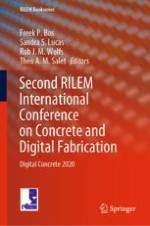2020 | OriginalPaper | Buchkapitel
Enhancing Buildability of 3D Printable Concrete by Spraying of Accelerating Admixture on Surface
verfasst von : Shantanu Bhattacherjee, Manu Santhanam
Erschienen in: Second RILEM International Conference on Concrete and Digital Fabrication
Aktivieren Sie unsere intelligente Suche, um passende Fachinhalte oder Patente zu finden.
Wählen Sie Textabschnitte aus um mit Künstlicher Intelligenz passenden Patente zu finden. powered by
Markieren Sie Textabschnitte, um KI-gestützt weitere passende Inhalte zu finden. powered by
